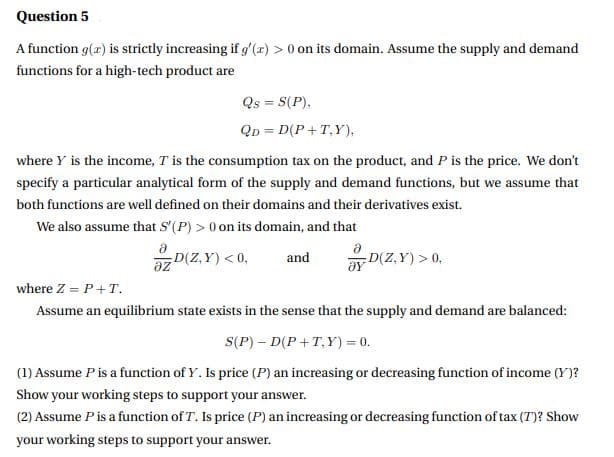A function g(z) is strictly increasing if g'(z) > 0 on its domain. Assume the supply and demand functions for a high-tech product are Qs = S(P), QD = D(P+T,Y), where Y is the income, T is the consumption tax on the product, and P is the price. We don't specify a particular analytical form of the supply and demand functions, but we assume that both functions are well defined on their domains and their derivatives exist. We also assume that S'(P) > 0 on its domain, and that
A function g(z) is strictly increasing if g'(z) > 0 on its domain. Assume the supply and demand functions for a high-tech product are Qs = S(P), QD = D(P+T,Y), where Y is the income, T is the consumption tax on the product, and P is the price. We don't specify a particular analytical form of the supply and demand functions, but we assume that both functions are well defined on their domains and their derivatives exist. We also assume that S'(P) > 0 on its domain, and that
Functions and Change: A Modeling Approach to College Algebra (MindTap Course List)
6th Edition
ISBN:9781337111348
Author:Bruce Crauder, Benny Evans, Alan Noell
Publisher:Bruce Crauder, Benny Evans, Alan Noell
Chapter5: A Survey Of Other Common Functions
Section5.4: Combining And Decomposing Functions
Problem 14E: Decay of Litter Litter such as leaves falls to the forest floor, where the action of insects and...
Related questions
Question
urgent....

Transcribed Image Text:Question 5
A function g(z) is strictly increasing if g'(z) > 0 on its domain. Assume the supply and demand
functions for a high-tech product are
Qs = S(P),
Qp = D(P +T,Y),
%3D
where Y is the income, T is the consumption tax on the product, and P is the price. We don't
specify a particular analytical form of the supply and demand functions, but we assume that
both functions are well defined on their domains and their derivatives exist.
We also assume that S'(P) > 0 on its domain, and that
D(Z,Y) > 0,
D(Z,Y) < 0,
and
az
where Z = P+T.
Assume an equilibrium state exists in the sense that the supply and demand are balanced:
S(P) – D(P +T,Y) = 0.
(1) Assume Pis a function of Y. Is price (P) an increasing or decreasing function of income (Y)?
Show your working steps to support your answer.
(2) Assume Pis a function of T. Is price (P) an increasing or decreasing function of tax (T)? Show
your working steps to support your answer.
Expert Solution
This question has been solved!
Explore an expertly crafted, step-by-step solution for a thorough understanding of key concepts.
Step by step
Solved in 3 steps

Recommended textbooks for you

Functions and Change: A Modeling Approach to Coll…
Algebra
ISBN:
9781337111348
Author:
Bruce Crauder, Benny Evans, Alan Noell
Publisher:
Cengage Learning

Algebra and Trigonometry (MindTap Course List)
Algebra
ISBN:
9781305071742
Author:
James Stewart, Lothar Redlin, Saleem Watson
Publisher:
Cengage Learning

Algebra & Trigonometry with Analytic Geometry
Algebra
ISBN:
9781133382119
Author:
Swokowski
Publisher:
Cengage

Functions and Change: A Modeling Approach to Coll…
Algebra
ISBN:
9781337111348
Author:
Bruce Crauder, Benny Evans, Alan Noell
Publisher:
Cengage Learning

Algebra and Trigonometry (MindTap Course List)
Algebra
ISBN:
9781305071742
Author:
James Stewart, Lothar Redlin, Saleem Watson
Publisher:
Cengage Learning

Algebra & Trigonometry with Analytic Geometry
Algebra
ISBN:
9781133382119
Author:
Swokowski
Publisher:
Cengage